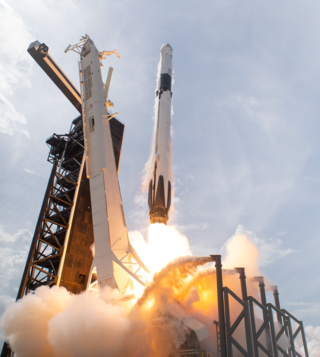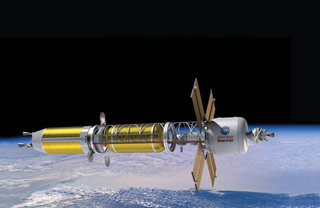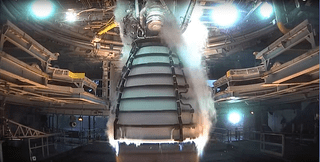After 22 years, Dr. Daniel Dorney, the NASA Technical Fellow for Propulsion, retired in August. Before he left, he reflected on a few of the more than 30 propulsion-related activities he led for the NESC and how expanding NASA’s propulsion discipline would be key to driving future exploration.
This article is from the 2022 NESC Technical Update.
After 22 years, Dr. Daniel Dorney, the NASA Technical Fellow for Propulsion, retired in August. Before he left, he reflected on a few of the more than 30 propulsion-related activities he led for the NESC and how expanding NASA’s propulsion discipline would be key to driving future exploration.
Seven-year-old Daniel Dorney was awestruck when Apollo 11 landed on the Moon, and he decided right then he would build his own, full-size Saturn V rocket. While collecting supplies, e.g., scraps of wood, wire, and bolts, he penned a letter to NASA Lewis (now NASA Glenn) requesting the rocket’s plans. A NASA engineer kindly replied that the plans couldn’t be shared, but Dorney wasn’t deterred. He sent a follow up letter with the plea, “But I really need the plans.” The same engineer responded, but this time with a blueprint for a kid-friendly rocket that required easier to find materials like juice cans and glue.
“That engineer took the time to answer not only one of my letters but two,” said Dr. Dorney. “That got me interested in astronomy, which got me interested in aerospace engineering.”
Whether by correlation, causation, or coincidence, Dr. Dorney ended up at NASA, ultimately serving as the Commercial Crew Program Launch Vehicle Chief Engineer and working the console for the first orbital test of the SpaceX Falcon 9 booster and Dragon 2 spacecraft. He was then competitively selected by the NESC to be the Agency’s Propulsion Technical Fellow.
In the last four years, Dr. Dorney has led more than 30 technical activities for the NESC, resolving propulsion anomalies with flight programs, delving into issues that have plagued the propulsion community since the Apollo era, and researching future technologies like nuclear propulsion that may help propel mankind to Mars and beyond.
One of his first assessments addressed the unexpected loss of an O-ring1 supplier that affected many NASA programs including Orion, Commercial Crew, and Mars 2020, which used O-rings in many of their pumps and valves. Dr. Dorney assembled a team of experts to look at replacement materials, an effort that took them to the White Sands Test Facility (WSTF) to assess the compatibility of the proposed alternates with NASA propulsion systems. “This assessment was so timely, and our results generated requests from all over the world because it was a question so many were trying to figure out.”
His plate stayed full, analyzing gas generator baffles, determining fundamental autoignition characteristics of isopropyl alcohol and ethanol,2 performing transient combustion modeling, and characterizing the thermal performance of insulation. Programs requested his help to find answers to various valve and thruster issues. In 2020, he began an evaluation of nuclear electric and thermal propulsion systems, both technologies being considered for Mars missions planned for the 2030s. “The assessment was a balancing act. We found some of the smartest people in nuclear propulsion with each half of the team supporting one type of propulsion.” The team helped determine technology maturity, find technology gaps, and guide architecture design and investment focus for Mars missions. “We ended up with a good final product and are still getting requests for that report.”3
Dr. Dorney also focused on addressing propulsion issues that have puzzled the propulsion community for decades with studies in material sensitivities, understanding cavitation4 in hydrogen peroxide, filtration5 standards for pressurized propulsion systems, helium solubility in propellants, using techniques like motion magnification to analyze gimbaled bellows,6 and updating and modernizing codes for combustion analysis.
Most recently, his team assessed the effects of pressure spikes on materials in hypergolic engines. “Pressure spikes and transients have been an issue for many programs and the issues have persisted since the Apollo Program.” While programs have found work arounds, a real solution was needed. “As providers look to reuse engines and components, there is a potential for accumulated damage from these spikes,” he said.
Testing and modeling of a hypergolic engine provided data on a material’s capability to withstand pressure spikes and the magnitudes that would cause material damage. To broaden the scope, he initiated an assessment to design, build, and test a highly instrumented 10-lbf class hypergolic thruster to pinpoint the origin and root cause of these pressure spikes. The results would be available to any organization using these types of thrusters.
“I’ve tried to focus my recent efforts on propulsion testing. A lot of people think we’ve done all we can with launch vehicle engines, that we understand everything with chemical propulsion, but there is still a lot more to be done. If we’re going to become interplanetary travelers, we have to work on ways to get to Mars in under 6 months and change the paradigm from here to the Moon. We need propulsion to get us further out much faster. I don’t think there is any part of the propulsion portfolio that we should stop investing in.”
After four years as the propulsion Technical Fellow, Dr. Dorney said it was time to retire. “In this position, 3 to 4 years is a good amount of time. Now it’s time to have the benefit of someone who has a different outlook and skill set so that the propulsion community gets to see another point of view.”
While the awestruck 7-year-old’s homemade Saturn V didn’t much resemble the one that landed on the Moon, it did likely launch his career in propulsion and put him on a road to the aerospace industry, a tenured engineering professorship, and ultimately to NASA. But what propelled him most were the people he worked with along the way.
“I have a broad colleague base,” he said, from his technical discipline team to the U.S. military and within academia. “I get a lot of questions that I don’t always know the answer to, but I know who will know the answer. And that is huge.”
- NESC Technical Bulletin No. 20-04: Alternative O-Rings for Hypergolic Propellant Systems.
- NESC Technical Bulletin No. 20-05: Determination of Autogenous Ignition Temperature of Isopropyl Alcohol and Ethanol.
- Assessment of the Technical Maturity of Nuclear Electric Propulsion and Nuclear Thermal Propulsion Systems. NASA/TM-2020-5006807.
- NESC Technical Bulletin No. 21-01: Experimental and Computational Study of Cavitation in Hydrogen Peroxide.
- NESC Technical Bulletin No. 22-02: Revisiting Filtration Standards and Definitions for Spaceflight Propulsion and Pressurant Systems.
- NESC Technical Bulletin No. 22-01: Detecting Flow-Induced Vibration in Bellows.




























